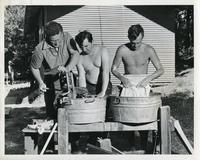(5,961 - 5,980 of 10,083)
Pages
-

-
Title
-
Civil Engineering students at Camp Armour, Vilas County, Wisconsin, 1942
-
Date
-
1942
-
Description
-
Photograph of Civil Engineering students doing their laundry at Camp Armour on Upper Trout Lake near Boulder Junction, Wisconsin. From caption...
Show morePhotograph of Civil Engineering students doing their laundry at Camp Armour on Upper Trout Lake near Boulder Junction, Wisconsin. From caption: "'Three little boys from school are we' might well be the anthem of these three Illinois Institute of Technology students who belong to the civil engineering department's six-week intensive summer surveying course at Camp Armour, northwoods classroom north of Minocqua, Wisconsin. Extra-curricular activity in this case includes the washing of clothes on Saturday morning, a regular feature of camplife. Left to right are: Irwin Lachman, 3910 Congress Street, a junior in September; Vance F. Zdarsky, 5138 S. Artesian Avenue, a senior in September, and John S. Jackimiec, 1651 S. Troy Street, likewise a senior. Camp Armour closed its twenty-seventh season last week (July 26)."
Show less
-
Collection
-
Office of Communications and Marketing photographs, 1905-1999
-

-
Title
-
Examining Partnership-Health Associations Among Lesbian Women and Gay Men Using Population-Level Data
-
Date
-
2019
-
Description
-
Abstract...
Show moreAbstract
Purpose: The aim was to provide the first broad assessment of partnership-health associations across partnership statuses among sexual minority individuals.
Methods: Using population-level data from the 2016 U.S. Behavioral Risk Factor Surveillance System, specifically the 26 states/territories that assessed sexual orientation and gender identity, we ran analyses of covariance and logistic regressions to compare lesbian and gay individuals (N = 2963) of different partnership statuses in general health, physical health and health conditions, mental health, health behaviors, and healthcare access/utilization domains.
Results: All omnibus and logistic regression models were significant (p < 0.001). Follow-up pairwise comparisons of mean differences across partnership groups revealed that in at least one variable in the general health, mental health, health behaviors, and healthcare access/utilization domains, married lesbian and gay individuals reported the best health, followed by partnered, single, and then divorced, separated, and widowed lesbian and gay individuals (p < 0.001). Exceptions included variables in the physical health and health conditions domain, the health behaviors of smoking and heavy drinking, and ever having an HIV test. When stratifying by sex, for both gay men and lesbian women being married or partnered related to the best health in at least one variable in each health domain, and in the majority of all outcome variables.
Conclusion: This article provides the first evidence for partnership-health associations among gay and lesbian individuals based on a large-scale, multi-domain test of population-level data. Future research could examine temporal links between same-sex marriage legislation and health outcomes among sexual minority individuals.
Show less
Pages